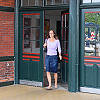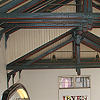                  |
East Gate Rail Station
The year is 1894. Worried that a new sea passage in Germany between the Baltic and the Channel would impact the position of Copenhagen as a sea trade port a new bonded harbor is inaugurated.
The State Railways eyed the opportunity to realize a long standing dream of a new railway covering the growing traffic along the coast between Copenhagen and Elsinore in the north.
Emphasizing the value addition that such new railroad would offer to the new bonded harbor the State Railways managed to achieve approval from the parliament to construct a passenger- and goods rail station at the location of the in 1858 abandoned Copenhagen East city gate.
The approval included laying of tracks to Elsinore and connections to the new bonded harbor. But more importantly, the parliament rejected a rail connection from this soon to be East Gate Rail Station to the existing Copenhagen railroad network centered at Copenhagen Central Rail station.
Hence, the station was only constructed as a "temporary" structure, awaiting a potential future approval to connect the station to the main station.
The year is 1894. Worried that a new sea passage in Germany between the Baltic and the Channel would impact the position of Copenhagen as a sea trade port a new bonded harbor is inaugurated.
The State Railways eyed the opportunity to realize a long standing dream of a new railway covering the growing traffic along the coast between Copenhagen and Elsinore in the north.
Emphasizing the value addition that such new railroad would offer to the new bonded harbor the State Railways managed to achieve approval from the parliament to construct a passenger- and goods rail station at the location of the in 1858 abandoned Copenhagen East city gate.
The approval included laying of tracks to Elsinore and connections to the new bonded harbor. But more importantly, the parliament rejected a rail connection from this soon to be East Gate Rail Station to the existing Copenhagen railroad network centered at Copenhagen Central Rail station.
Hence, the station was only constructed as a "temporary" structure, awaiting a potential future approval to connect the station to the main station.
State Railways chief architect, Heinrich Wenck, designed the new East Gate Rail Station -Østerport.
The same Mr. Wenck also designed the rail stations along the northern route and later, in 1904-11, Copenhagen's brand new Central Rail Station.
The design reflected the temporary nature of the building and did not sit well with the media at the inauguration on 1st August 1897: "The open woodwork kept in red and green colors influenced by an antiquated lack of style renders a strange and pompous impression" (Kbhvn, p.349).
Woodwork is indeed a dominant feature of the building; outside, as a visible part of the main structure between the red brick, and inside, as a strong accent in the ceilings and double staircases.
True to architecht Wenck's ideal, Østerport has large, open halls with large arched windows, which allow plenty of natural light inside.
The original clock tower was replaced already in 1917 by a simple control room, but in 1983 the tower was fortunately rebuilt true to the original 1894 design.
The station derives its name -Østerport- from the city gate, which controlled the eastern access to the city from the 1600's till its removal in July 1858.
Despite its name, the station is located closer to where the former toll gate ("konsumtionsbod") was on the ravelin island just north of the city gate.
The ravelin island was part of the moat system, which protected Copenhagen city since the 1600's. The moat used to be the forward defense of the Citadel, which can still be found right next to Østerport station.
The moat system northeast of Østerport was filled in 1894-97 and converted to the still existing, wide railway trench.
The ravelin island was at the same time expanded to a large dam to allow for a wide avenue and the railway station -this area is today named "Oslo square".
This explains the reason for the characteristic staircases leading from the station building down to the tracks, which in fact occupy the former city moat bed.
The large, light halls, the use of wood as a prominent design feature, the lively red and green colors inside, and the combination of red brick and black painted wood outside are all part of architect Wenck's unique design preferences clearly reflected in Østerport station.
The black slate covered roofs are similar to the central railway station, but little effort was spent on using the brick in a decorative manner as done in the central station since Østerport station was expected to be replaced after a few years. It's still there a century later!
The uniquely designed, large chandeliers inside the halls are a study on their own. They originally hung in the central railway station but were since moved to Østerport station.
Note the use of minitowers with spires as well as the clock in the central (rebuilt) tower. Another great feature are the smiling animals in green painted wood, which decorate all the roofback ends.
For a "temporary" building Østerport station has been quite resilient, having survived more than a century. More than 4,000 people pass through this station each opening hour.
There have been plans to replace it, but despite the first indignation, Copenhageners have since taken the building to their hearts.
Only the building -knicknamed the Pillarhouse ("Søjlehuset")- housing some shops just south of the station was replaced in the 1990's.
The former goods handling building south of the main tracks is still extant but is now restored and used as a training center after goods handling was moved to another location.
Sources:
"København før og nu" ("Kbhvn")
Own photos taken August 2009
Old photos: Copenhagen city museum and Kbhvn
display program by Matteo Bicocchi
                  |





